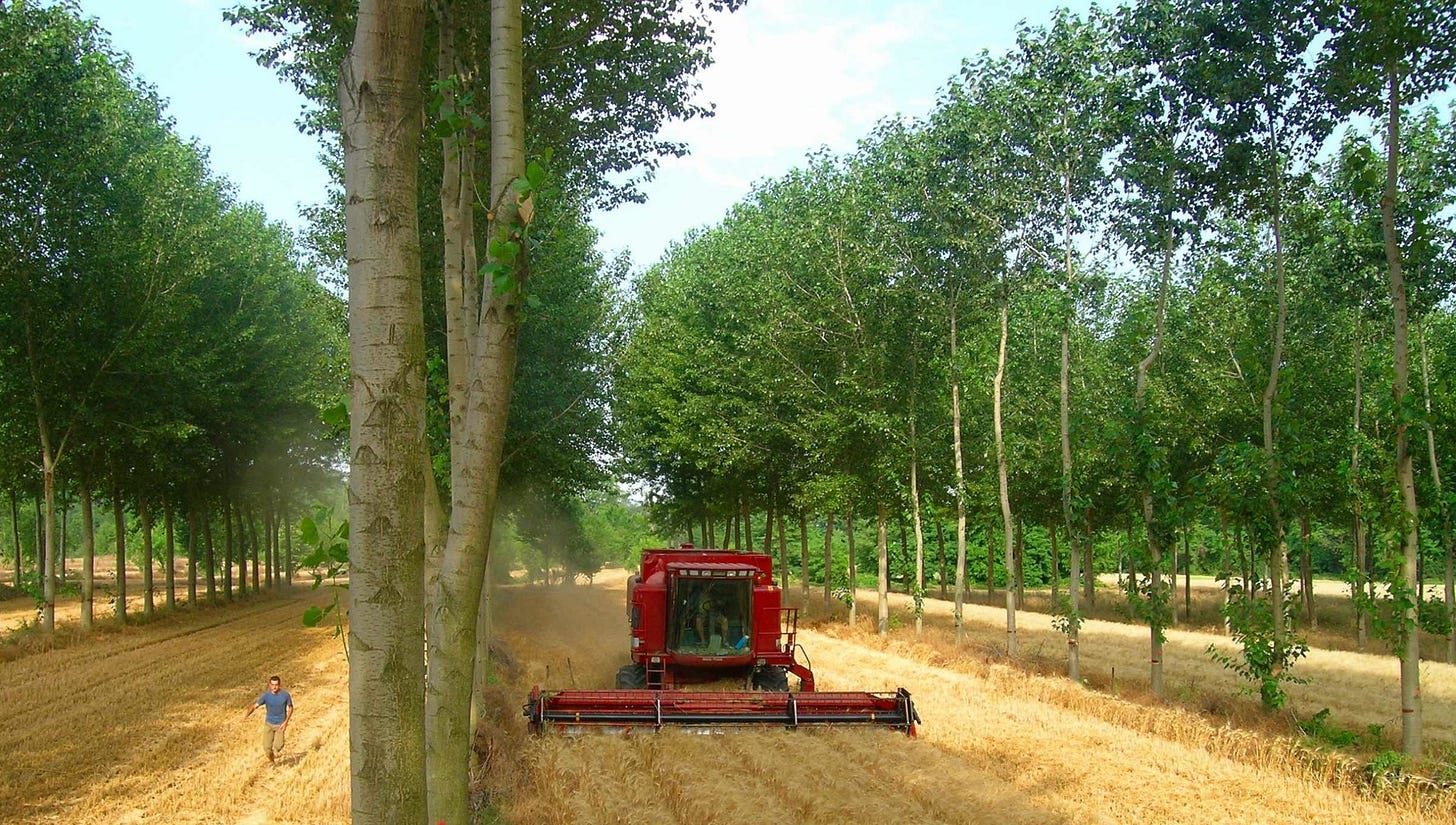🌳 Agroforestry: Growing money on trees?
Welcome back to The Regeneration Weekly, a newsletter delivering regenerative food and agriculture news to your inbox every Friday. Not a subscriber yet?
Progress: On a global scale, humankind is facing an environmental crisis connected to the way we use and abuse the land. Modern agriculture's reliance on monocultures (one-crop production systems) threatens the fertility of our soil. And in the long term, these extractive practices threaten the well-being and prosperity of humanity. To prevent this outcome, a small subset of US landowners is blurring the lines between agriculture and forestry by integrating trees to improve marginal farmland and increase profitability.
Simply speaking, agroforestry is a cultivation system in which fruit, nut, and timber trees or shrubs are purposefully grown among crops or pastureland. Although rare in the US, this practice is used across at least 1.6 billion acres of land worldwide. Agroforestry mimics the way in which organisms (plants or animals) support each other through the exchange of nutrients, water, and shade in natural ecosystems. The two most prominent forms of agroforestry include agri-silviculture and silvopasture. Agri-silviculture often incorporates alley-cropping, which combines rows of trees such as orchards with annual or perennial crops in the space between rows, whereas silvopasture systems graze animals on pastures with tree cover or orchards.
In short, agroforestry yields a range of benefits including:
Drawing down emissions: Through photosynthesis, trees, plants, and fertile soils can become carbon sinks - naturally pulling carbon dioxide (CO2) out of the atmosphere. Converting forest to cropland emits anywhere 62 to 120 tons of carbon per hectare. Whereas adding trees into existing cropland can sequester 2 to 8 tons of carbon per acre per year. This method is even more powerful when used in tandem with holistically managed grazing.
Increasing land productivity: Compared to monocultures, agroforestry systems retain up to 53 percent more nitrogen and 17 percent more phosphorus. And over a 10 year period, agroforestry systems can be up to 30 percent more productive than one-crop systems. This method produces more food on the same amount of land by taking advantage of vertical space and improving soil quality. Adding trees to cropland also provides shelter and habitat for other species and pollinators - fostering a more robust ecosystem that can endure disease and extreme weather.
Growing farmer profitability: In addition to enhancing land productivity, practicing agroforestry diversifies revenue streams for farmers. Trees are permanent crops that produce high-margin fruits, nuts, timber, and biomass - generating up to eight times more profit than a traditional row crop operation. Growers are also able to reduce or eliminate the application of costly pesticides and insecticides because the increased amount of living organisms (insects and birds) act as a natural pest management system. And as carbon markets become commercially viable, agroforestry will become a tool that helps monetize land conservation efforts by offering farmers additional profit for storing CO2 in their soil and biomass.
Regenerative agroforestry has the potential to increase farmer profitability while improving biodiversity and soil quality. Yet its variability makes it a complex agricultural investment. At the moment, several bottlenecks hinder the growth of the movement in the US.
Education: Agroforestry comes with an initial learning curve. Fusing crops with trees can be difficult without prior knowledge of tree genetics or how certain plants interact with shade. For example, trees planted too close together can shadow crops that are not tolerant to shade. In this scenario, agroforestry systems can negatively impact plant growth.
Capital: The cost needed to start growing trees is high, especially compared to the investment for annual cash crops. Many farmers do not have the extra capital to cover the operating expenses for 3-5 years until their nut, fruit, or timber trees are productive. Companies like Propagate Ventures and Salo Sciences are solving this problem by building technology that makes it simpler for landowners to access alternative financing channels. Both platforms also speed up the process of designing, implementing, and monetizing conservation efforts.
In the race to reforest America’s farmland, we should not narrowly focus on the sheer number of trees planted. Instead, we must think about using trees or shrubs to better balance agro-ecosystems and generate income for rural communities. Before the forest farming movement can become commonplace, policymakers and innovators must continue to make it easier for landowners to access agroforestry resources and services. Once this happens, farmers will be able to design agricultural systems that are more self-sufficient and resilient.
Watch: In Food, Inc., documentarian Robert Kenner exposes our nation’s highly centralized and mechanized food industry. With the help of Eric Schlosser and Michael Pollan, this film illustrates how most American food is grown by a handful of multinational corporations with the consent of our government's regulatory agencies. This film uncovers that the US food supply has been seized by large producers that put profit ahead of public health, animal welfare, the livelihood of small farmers, and the environment. Food, Inc. is a must-watch for anyone interested in learning more about how industrial agriculture is degrading the health of people and our planet.
Shop: Rewild Organics believes that regenerative superfoods are medicine for the body, mind, and spirit. The company’s mission is to nurture and protect the Costa Rica rainforest by cultivating and crafting plant medicines that bring nourishment and balance to people everywhere. Every product they sell helps to build regenerative supply chains, support small farming communities, reforest crucial wildlife habitats, protect watersheds and restore habitat in their nearby rainforest. Our readers can use code “THEREGENERATION20” at checkout for 20% off their next order.
The Regeneration is brought to you by Wholesome Meats | Soilworks | PastureMap.






